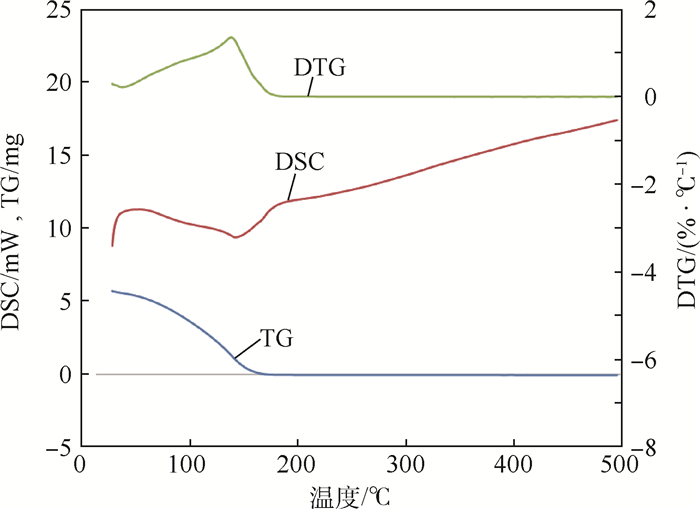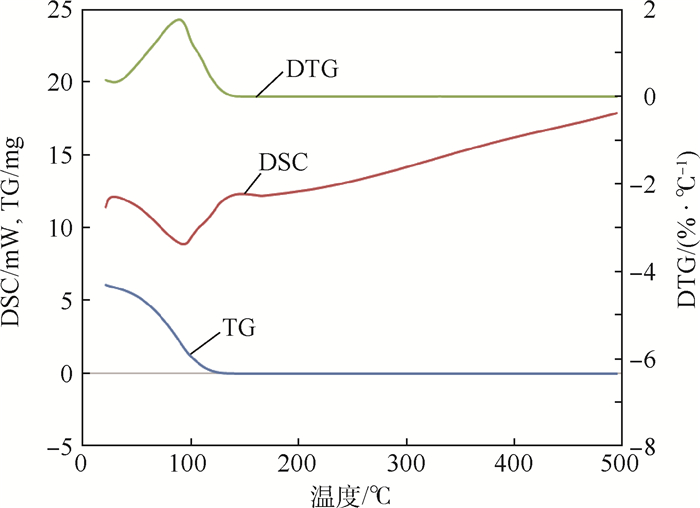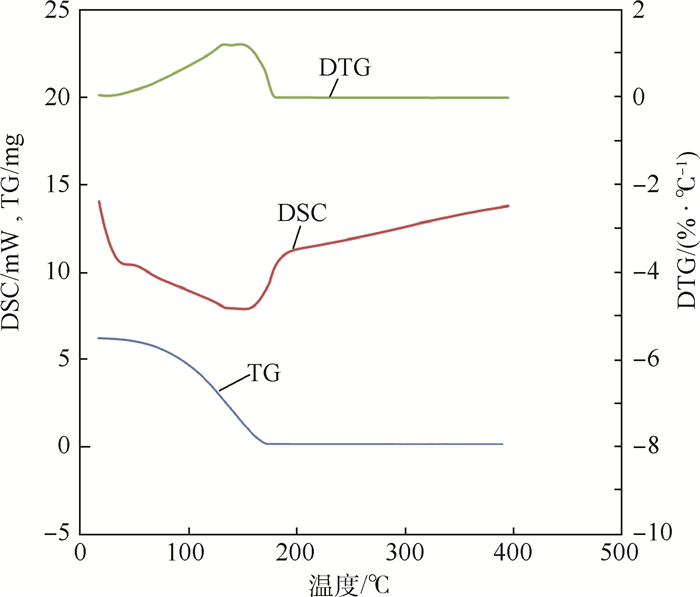-
摘要:
航空燃料安定性和热沉对飞机和发动机工作可靠性、飞机飞行安全及战术性能的发挥有重要作用。利用热重-差热分析联用仪研究了2种典型微藻航油的热氧化安定性和热沉,并与标准航空喷气燃料RP-3进行了对比。结果表明:混合生物油的失重终点温度和最大失重点的温度与标准航空喷气燃料RP-3相比均向高温区移动。在失重区间内,除了物理热沉还有化学热沉的贡献。在热重曲线中定义了2个无量纲参数:引发温度和燃尽指数,引发温度表征起始裂解温度,燃尽指数表征沉积特性。2个参数结合可以较好地诠释燃料的热安定性和热沉。球等鞭金藻油高碳数烷烃在提高热沉基础上导致碳沉积的形成,但小球藻油在热沉提高的基础上,并没有形成碳沉积。说明通过有效控制高碳数烷烃分配比例增加其热沉并控制其积碳在理论和技术上是可行的。
Abstract:The thermal stability and heat sink of aviation fuel play an important role in the reliability, safety and performance of aircraft and engine. Two types of typical microalgae aviation fuel were investigated to assess thermal stability and heat sink by thermo-gravimetric-differential scanning calorimetry in comparison with the standard turbine jetfuels RP-3. The results show that the temperatures of the end point and maximum weight loss point are higher than that of the standard turbine jetfuels RP-3, which indicates that heat sink includes both physical heat sink and chemical heat sink in weight loss interval. The thermo-gravimetric curve defines two dimensionless parameters including initiation temperature and burnout index, which represent the initial decomposition temperature and the deposition characteristics respectively. The combination of the two parameters can be used to assess the thermal stability and heat sink. Isochrysis based blend aviation fuel presented the carbon deposit with the increase of heat sink, while chlorella based blend aviation fuel did not present the carbon deposit with the increase of heat sink. The results indicate that optimizing the composition of alkane with high carbon number could increase heat sink and decrease carbon deposit. It is feasible both theoretically and technically.
-
Key words:
- microalgae aviation fuel /
- thermal stability /
- heat sink /
- initiation temperature /
- burnout index
-
生物航空燃料是将生物质或生物油脂经过炼制获得的液体航空燃料。海藻、麻风树因避免了“与人争粮”、“与粮争地”的问题,而且对淡水消耗少,成为未来最具应用潜力的航空燃料的可持续发展原料[1]。在应对全球气候变化方面,生物航空燃料较传统航空燃料以及煤基、天然气合成燃料不仅在节省水资源方面,而且在碳减排上也显示明显优势,其温室气体排放量比传统航空燃料减少30%~90%[2]。
喷气燃料的热氧化安定性与热沉直接影响飞机和发动机的工作可靠性[3]、飞机飞行安全及战术性能的发挥[4]。与燃料质量有关的飞机、发动机故障中,约有一半是由燃料的热氧化安定性问题造成的[5]。产生此问题的主要原因是喷气燃料不仅作为飞机的动力源,而且被用作热沉从系统中移除废热负荷[6]。喷气燃料通过燃油系统换热后温度升高,引起氧化、热分解、降解和蒸发,导致生成不溶性沉积物。不溶性沉积物堵塞飞机燃料系统喷嘴、管路、过滤器和注射泵等部件,导致燃料供给系统不能正常使用,发动机不能正常工作,给飞行安全带来隐患。
热沉值是评定燃料吸热能力大小的性能指标,燃料在进入燃烧室燃烧之前流经发动机的高温部件, 利用物理、化学吸热将高温部件热量带走[7-8], 一方面储存热能, 另一方面又可提高燃烧效率。但化学热沉的释放要求不能引起结焦和积碳的出现。
热氧化安定性是衡量喷气燃料生成不溶性沉积物倾向重要指标,喷气燃料热氧化安定性也同时表征沉积物形成趋势[9]。航空燃料的安定性根据其产生变化的原因分为物理安定性、化学安定性和热安定性。物理安定性是指在一定外界条件变换范围内保持其物理性质不变的能力;化学安定性通常是指氧化安定性,是指燃料在低温液相条件下,其抵抗氧化变质生成胶质的能力;热安定性是指在较高温度条件下燃料保持良好性能,不发生分解、聚合生成沉淀的能力。热安定性实际上就是在较高温度下的抗沉积能力,是衡量能否用于高声速飞机的重要指标。美国燃料JP-7就是根据燃料组分的安定性,设计一种由烷烃和环烷烃组成的精制煤油燃料。
目前航空替代燃料要求简单易用,即“Drop-in”即用型燃料,对飞机和发动机硬件无需改动。生物燃料安定性研究已经引起研究者的关注[10-11],但是针对微藻航空替代燃料热氧化安定性和热沉的研究还未见报道。本文利用热重-差热分析联用仪研究了微藻航油的安定性和热沉,并与标准航空喷气燃料RP-3进行了对比,分析影响燃料安定性和热沉的主要因素,探讨了碳沉积的机理,为微藻生物航油应用奠定理论与技术基础。
1. 实验方法
1.1 热重-差热分析方法
实验采用Q600SDT TG-DTG-DSC(热重分析-热重微分-差热扫描)同步测定仪,测试温度范围为20~500 ℃。实验采用99.99%的氮气作为保护气,升温过程中氮气流量控制在100 mL/min,升温速率为10 ℃/min,升温过程的失重和吸热自动采集,由计算机处理形成TG、DTG和DSC曲线。
1.2 微藻航油组成
小球藻和球等鞭金藻是微藻能源中的典型藻种,其藻脂肪酸主要组成为C14、C16和C18,脱氧加氢后主要组成是C14、C16和C18的直链烷烃。其中小球藻油烷烃组成为C14:C16:C18=2:47:51,球等鞭金藻油烷烃组成为C14:C16:C18=18:23:59。
2. 实验结果与分析
2.1 微藻航空燃料与标准航煤组成差异
标准航空喷气燃料组成是以烷烃为主要组分的碳氢燃料,其碳数分布主要集中在C8~C16之间,是以碳数为12的碳氢化合物为中心、以C8~C16为正态分布的碳氢化合物,其中碳数小于C7和高于C16的碳氢化合物均分别小于3%。标准航空喷气燃料组成中正构烷烃与异构烷烃分别占比25.03%和20.06%,环烷烃占比10.56%,芳香烃占比28.75%。环烷烃、芳香烃的碳数分别主要集中在C8~C14和C7~C13之间,略低于烷烃类。
不同国家、不同炼制工艺得到的航空燃料组成分布及碳数分布具有相似性,这是因为航空燃料虽然没有组成的严格规定,但具有严格的性质规定范围。除了安定性外,其还必须满足低温性(冰点),流动性(黏度、密度、馏程),燃烧性(闪点、烟点、热值、点火能量),清洁性(水含量、机械杂质)及安全性(燃烧极限),以保证航空发动机和飞机的表现性能和安全性能。这些性质的需求在一定程度上限制了航空燃料的族组成与碳数分布。
由于微藻航空燃料主要来源于脂肪酸脱氧后的加氢,其主要由正构烷烃组成,芳香烃及环烷烃含量较低。按照美国材料与试验协会(American Society for Testing and Materials, ASTM)要求,掺混比例不得高于50%,2种典型微藻航空燃料与标准航空喷气燃料(RP-3)50%掺混后的组成见表 1。
表 1 微藻航空燃料50%掺混比与RP-3组成Table 1. Composition of mixed RP-3 and microalgae aviation fuel 50%% 组分 碳数分布 小球藻油+RP-3 球等鞭金藻油+RP-3 RP-3 正构烷烃 C8~C18 62.5 62.5 25.03 C14 3.3 11.3 2.3 C16 23.7 11.7 0.19 C18 25.5 29.5 — 异构烷烃 C8~C16 10.0 10.0 20.06 环烷烃 C8~C14 5.3 5.3 10.56 芳香烃 C7~C13 14.4 14.4 28.75 烯烃 C9~C11 1.5 1.5 3.06 其他 6.3 6.3 12.5 小球藻油特点是C14含量少,主要是C16和C18,而球等鞭金藻油C18含量高,并含有11.3%的C14。50%掺混后2种生物航空燃料主要表现是高碳数烷烃含量特别是其中C16与C18的烷烃类组分明显增加,碳数分布向高碳数移动,同时环烷烃、芳香烃类组成与标准航空喷气燃料相比含量下降。
2.2 燃料的热重与差热分析
分析TG和DTG曲线,标准航空喷气燃料RP-3失重区间在30~150 ℃之间,最大失重温度90.2 ℃;RP-3与小球藻油混合油的失重区间为30~185 ℃之间,最大失重温度139 ℃;RP-3与球等鞭金藻油的混合油的失重区间为30~200 ℃之间,最大失重温度149 ℃。TG和DTG曲线结果表明混合生物油的失重终点温度和最大失重点的温度与标准航空喷气燃料RP-3相比均向高温区移动。
RP-3以及RP-3与小球藻油混合油没有积碳沉积,终点温度没有检测到其他剩余物质。RP-3与球等鞭金藻油的混合油在热重分析的终止温度出现了0.2%的碳沉积残渣。对比2种微藻油与燃料的TG曲线和DTG曲线差异,掺混油中高碳数烷烃增加,球等鞭金藻油的高碳数烷烃C18含量又高于小球藻油,这与高碳数烷烃气化温度较高相吻合。而球等鞭金藻油积碳的发现,说明高碳数组成比例的增加会引发热分解积碳。
分析DSC曲线,RP-3吸热曲线峰值在94.5 ℃,RP-3与小球藻油的混合油在143 ℃时吸热最大,RP-3与球等鞭金藻油的混合油在151 ℃时出现最大吸热温度。与标准航空喷气燃料的TG曲线和DTG曲线结果对应,均向高温区移动。
对3种样品升温过程伴随失重过程吸收的热流积分得到RP-3热沉为1.29 MJ/kg,RP-3与小球藻油混合油热沉为1.68 MJ/kg,RP-3与球等鞭金藻油的混合油的热沉为1.54 MJ/kg。说明高碳数烷烃含量增加导致燃料的热沉增加,热沉增加说明燃料吸热能力增加。燃料吸热包括物理吸热和化学吸热。物理吸热由显热和潜热2部分组成,由于微藻油中增加的主要是C14、C16和C18,而且失重区间主要发生在C14、C16和C18烷烃气化温度前,说明物理吸热主要是显热吸热。比较C14、C16和C18在150 ℃的比热容,C14为2.599kJ/(kg·K),C16为2.499 kJ/(kg·K),C18为2.552 kJ/(kg·K),根据其含量变化,由于组成变化导致RP-3与小球藻油混合油比热容升高1.26 kJ/(kg·K),RP-3与球等鞭金藻油混合油比热容升高1.27 kJ/(kg·K)。从物理吸热分析,RP-3与球等鞭金藻混合油的热沉应该高于RP-3与小球藻油混合油,但小球藻油的总热沉却高于球等鞭金藻油总热沉。因此,其中除了物理热沉还有化学热沉,即C14、C16和C18烷烃的分解增加了燃料的化学热沉。
2.3 影响微藻航空燃料热氧化安定性和热沉因素分析
影响燃料热氧化安定性和热沉最根本的因素是燃料自身的化学组成。不同燃料的族组成有其自身的热氧化安定性和热沉性质。
为分析比较不同航空燃料的热氧化安定性和热沉,依据TG曲线和DTG曲线建立2个参数:引发温度与燃尽指数。引发温度建立在TG曲线最大失重点基础上,以微分热重峰值点在TG曲线上做切线与起始失重基线的交点,该交点对应的温度定义为引发温度,其表征开始热解反应的引发温度。燃尽指数表征是否有沉积,定义燃尽指数为100%减去失重结束时残渣重量与初始重量的百分比。如果完全燃尽即无剩余残渣,则燃尽指数为100%。
引发温度反映了起始分解的温度,燃尽指数表征了沉积特性。从表 2可以看出,RP-3引发温度为61.9 ℃,RP-3与小球藻油的混合油引发温度93.1 ℃,RP-3与球等鞭金藻油的混合油引发温度为91.9 ℃。对比最大失重温度,微藻的引发温度移动到高温区,球等鞭金藻油引发温度比小球藻油提前。
表 2 引发温度与燃尽指数Table 2. Initiation temperature and burnout index航空燃料类型 组分 引发温度/℃ 最大失重温度/℃ 最大吸热温度/℃ 燃尽指数/% C14 C16 C18 小球藻油+RP-3 3.3 23.7 25.5 93.1 139 143 100 球等鞭金藻油+RP-3 11.3 11.7 29.5 91.9 149 151 99.8 RP-3 2.3 0.19 — 61.9 90.2 94.5 100 航空燃料组成根据官能团主要分为直链烷烃、支链烷烃、环烷烃、芳烃类以及其他少量不饱和烃及含氧、硫和氮的化合物。
饱和烃类包括直链、支链烷烃和环烷烃,其化学性质、物理性质及热性能都较稳定,安定性较其他组分好。不饱和烃化学性质不稳定,易发生氧化反应生成醇、醛和酸等。含氧、硫和氮化合物最容易氧化分解并引起沉积物的生成。因此,烃类化合物热分解过程复杂,不同族组成物质不仅各自发生断链、异构化、脱氢环化、脱烷基、脱氢交联和焦化反应,而且相互之间也可以发生相应的反应。支链烷烃的C—C键和C—H键的键能比直链烷烃对应的C—C键和C—H键的键能小,C—C键比C—H键键能小,根据键能裂解或脱氢的顺序:支链烷烃的C—C键—直链烷烃的C—C键—C—H键[12-13]。即烷基支链的稳定性低于同碳原子数的直链烷烃,而直链烷烃低于环烷烃的热安定性。
从燃料化学组成分析,标准航空喷气燃料RP-3支链烷烃含量高,在低温时就显示出分解反应的迹象,表现为引发温度较低;其次是球等鞭金藻油,分析原因是C16、C18高碳数烷烃含量较高,其比小球藻油提前出现了分解迹象。实验结果证实了直链烷烃随着碳数增加易断链,进一步说明燃料组分的改变可引起燃料安定性的显著变化。从燃尽指数分析,球等鞭金藻油燃尽指数下降为99.8%,说明引起了热沉积现象的发生。这个结果表明在航空燃料中要控制C18在航空燃料中的含量及比例,其会引起碳沉积。
对比热沉的变化,RP-3热沉为1.29 MJ/kg,RP-3与小球藻油混合油热沉为1.68 MJ/kg,RP-3与等鞭金藻油的混合油的热沉为1.54 MJ/kg。而由于C14、C16、C18组成变化导致PR-3与小球藻油混合油比热容升高1.26 kJ/(kg·K),PR-3与球等鞭金藻油混合油比热容升高1.27 kJ/(kg·K),物理热沉的变化与总热沉变化出现的差异进一步说明化学热沉的发生。
沉积物的形成机理非常复杂,在不同的温度范围不同环境其反应机理也不同,碳沉积机理主要有低温时的液相自氧化(25~260 ℃),高温时高温裂解(≥400 ℃)。由于热重-差热分析是在氮气环境下完成,且3种样品的失重温度均小于200 ℃,说明PR-3与球等鞭金藻油混合油形成的碳沉积主要是燃料与燃料溶解的溶解氧反应生成。虽然结焦反应是放热过程,但其会显著降低燃料的有效热沉,碳沉积可能是PR-3与球等鞭金藻油混合油总热沉降低的原因。
燃料在较低温度发生氧化反应的自氧化机理主要是由链反应引起的。自由基的引发是其关键步骤,即通过RH→R·+H·,或R1R2→ R1·+R2·反应产生自由基;接下来通过传递反应R·+O2→ RO2·,RO2·+RH → ROOH+R·进行加速,RO2·很活泼,能够导致醇、醚、酸的生成和碳链增长,形成胶质类物质;最后,当反应体系自由基消耗生成稳定产物,链反应终止,氧化反应终止[14-15]。
燃料低温氧化产物形式主要为胶质。胶质极其不稳定,在升温过程中,醇醛缩合等反应导致碳链增长,酸脱羧、脱氢导致异构、环化等反应发生,最终形成碳沉积。发生反应的关键是链引发,由于C—C键能小于C—H键能,而高碳数烷烃其C—C键能低,容易发生分解引起链反应。
小球藻油和球等鞭金藻油热沉均增加,均说明增加链反应的可能性就增加了燃料的化学热沉,这是其有利的一面。但球等鞭金藻油由于C18高碳数烷烃含量高,其氧化过程最后导致碳沉积的形成,将对其应用产生不利的影响;而小球藻油在热沉提高的基础上,并没有积碳沉积的出现。因此,研究表明通过有效控制高碳数烷烃增加其热沉并控制其积碳在技术上是可行的。
3. 结论
1) 标准航空喷气燃料RP-3和2种微藻油的掺混油热重-差热联合分析结果表明,2种微藻油的掺混油热沉均高于RP-3,RP-3与球等鞭金藻油的混合油由于高碳数烷烃含量的升高,安定性下降,显示了0.2%的碳沉积。
2) 热重和热重微分研究表明,标准航空喷气燃料RP-3失重区间在30~150 ℃之间,最大失重温度在90.2 ℃;RP-3与小球藻油混合油的失重区间在30~185 ℃之间,最大失重温度139 ℃;RP-3与球等鞭金藻油的混合油的失重区间为30~200 ℃之间,最大失重温度149 ℃。
3) RP-3以及RP-3与小球藻油混合油没有积碳沉积,燃尽指数为0。RP-3与球等鞭金藻油的混合油燃尽指数0.2%,出现了碳沉积,分析是由高碳数的烷烃热分解导致的积碳。
4) RP-3热沉为1.29 MJ/kg,RP-3与小球藻油混合油热沉为1.68 MJ/kg,RP-3与球等鞭金藻油的混合油的热沉为1.54 MJ/kg,说明高碳数烷烃含量增加了燃料的热沉,而且除了物理热沉还有化学热沉的贡献。
5) RP-3与球等鞭金藻油混合油形成的碳沉积主要是燃料与燃料溶解的溶解氧反应生成。在低温发生通过链反应生成胶质,温度升高,胶质发生分解聚合等反应形成积碳。
6) 球等鞭金藻油高碳数烷烃在提高热沉基础上导致碳沉积的形成,但小球藻油在热沉提高的基础上,并没有形成碳沉积。说明通过有效控制高碳数烷烃分配比例可增加其热沉并控制其积碳在理论和技术上是可行的。
-
表 1 微藻航空燃料50%掺混比与RP-3组成
Table 1. Composition of mixed RP-3 and microalgae aviation fuel 50%
% 组分 碳数分布 小球藻油+RP-3 球等鞭金藻油+RP-3 RP-3 正构烷烃 C8~C18 62.5 62.5 25.03 C14 3.3 11.3 2.3 C16 23.7 11.7 0.19 C18 25.5 29.5 — 异构烷烃 C8~C16 10.0 10.0 20.06 环烷烃 C8~C14 5.3 5.3 10.56 芳香烃 C7~C13 14.4 14.4 28.75 烯烃 C9~C11 1.5 1.5 3.06 其他 6.3 6.3 12.5 表 2 引发温度与燃尽指数
Table 2. Initiation temperature and burnout index
航空燃料类型 组分 引发温度/℃ 最大失重温度/℃ 最大吸热温度/℃ 燃尽指数/% C14 C16 C18 小球藻油+RP-3 3.3 23.7 25.5 93.1 139 143 100 球等鞭金藻油+RP-3 11.3 11.7 29.5 91.9 149 151 99.8 RP-3 2.3 0.19 — 61.9 90.2 94.5 100 -
[1] 赵晶, 郭放, 阿鲁斯, 等.未来航空燃料原料可持续性研究[J].北京航空航天大学学报, 2016, 42(11):2378-2385.ZHAO J, GUO F, A L S, et al. Evaluation of the sustainable feedstock for alternative aviation fuels[J].Journal of Beijing University of Aeronautics and Astronautics, 2016, 42(11):2378-2385(in Chinese). [2] 任海涛, 郭放, 杨晓奕.中国微藻航空煤油制备潜能及CO2减排[J].北京航空航天大学学报, 2016, 42(5):912-919.REN H T, GUO F, YANG X Y.Potential production of microalgae bio-jet fuel and CO2 emissions reduction in China[J].Journal of Beijing University of Aeronautics and Astronautics, 2016, 42(5):912-919(in Chinese). [3] 贾春燕, 王洪铭.航空发动机燃烧室喷嘴内部燃油结焦研究[J].航空发动机, 2011, 37(5):41-44.JIA C Y, WANG H M.Investigate on fuel coke in nozzle of aeroengine combustor[J].Aeroengine, 2011, 37(5):41-44(in Chinese). [4] 范启明, 米镇涛, 于燕.高超音速推进用吸热型烃类燃料的热稳定性研究Ⅰ.热氧化与热裂解沉积[J].燃料化学学报, 2002, 30(1):78-82. doi: 10.3969/j.issn.0253-2409.2002.01.017FAN Q M, MI Z T, YU Y.Study on thermal stability of endothermic hydrocarbon fuels for hypersonic propulsionⅠ.Thermal oxidation & pyrolytic deposit[J].Journal of Fuel Chemistry and Technology, 2002, 30(1):78-82(in Chinese). doi: 10.3969/j.issn.0253-2409.2002.01.017 [5] 张冬梅, 张怀安, 曹文杰, 等.喷气燃料热安定性对飞机发动机的影响[J].航空制造技术, 2008(13):91-93. doi: 10.3969/j.issn.1671-833X.2008.13.018ZHANG D M, ZHANG H A, CAO W J, et al.Effects of the heat stability of the jet fuels on the aeroengine[J].Aeronautical Manufacturing Technology, 2008(13):91-93(in Chinese). doi: 10.3969/j.issn.1671-833X.2008.13.018 [6] 范启明. 高超音速推进用吸热型烃类燃料的氧化与裂解过程研究[D]. 天津: 天津大学, 2002: 5-20.FAN Q M. Study on oxidation and cracking processes of endothermic hydrocarbon fuels for hypersonic propulsion[D]. Tianjing: Tianjing University, 2002: 5-20(in Chinese). [7] PETLEY D.Thermal management for a mach 5 cruise aircraft using endothermic fuel-aircraft design, systems and operations conference (AIAA)[J].Journal of Aircraft, 1992, 29(3):384-389. doi: 10.2514/3.46173 [8] EDWARDS T. USAF supercritical hydrocarbon fuels interests[C]//Aerospace Sciences Meeting. Reston: AIAA, 2013. [9] 曲海杰. 高热安定性碳氢燃料的结构设计[D]. 天津: 天津大学, 2007: 5-20.QU H J. System design of high thermal-stable hydrocarbon fuel[D]Tianjing: Tianjing University, 2007: 5-20(in Chinese). [10] HARI T K, YAAKOB Z, BINITHA N N.Aviation biofuel from renewable resources:Routes, opportunities and challenges[J].Renewable & Sustainable Energy Reviews, 2015, 42:1234-1244. [11] BAROUTIAN S, AROUA M K, RAMAN A.Blended aviation biofuel from esterified Jatropha curcas, and waste vegetable oils[J].Journal of the Taiwan Institute of Chemical Engineers, 2013, 44(6):911-916. doi: 10.1016/j.jtice.2013.02.007 [12] COMMODO M, FABRIS I, GROTH C P T, et al.Analysis of aviation fuel thermal oxidative stability by electrospray ionization mass spectrometry(ESI-MS)[J].Energy & Fuels, 2011, 25(5):2142-2150. [13] AMARA A B, KAOUBI S, STARCK L.Towards an optimal formulation of alternative jet fuels:Enhanced oxidation and thermal stability by the addition of cyclic molecules[J].Fuel, 2016, 173:98-105. doi: 10.1016/j.fuel.2016.01.040 [14] OLDANI A. Surrogate modeling of alternative jet fuels for study of autoignition characteristics[D]. Urbana: University of Illionois at Urbana-Champaign, 2014. [15] SALDANA D A, CRETON B, MOUGIN P, et al.Rational formulation of alternative fuels using QSPR methods:Application to jet fuels[J].Oil & Gas Science & Technology, 2013, 68(4):651-662. 期刊类型引用(1)
1. 刘宇,汤卓,孙震,王金铎,马洪安,曾文. 小球藻油/RP-3航空煤油混合燃料的层流燃烧特性. 航空动力学报. 2019(08): 1663-1670 .  百度学术
百度学术其他类型引用(0)
-







 下载:
下载:




 下载:
下载:


 百度学术
百度学术




